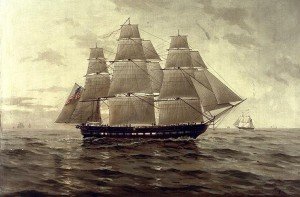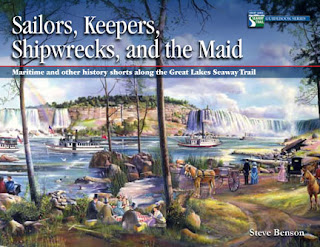 During the War of 1812 the dogs of war barked and bit along the U.S. northern frontier from Lake Ontario to Lake Champlain as American forces tangled with their British and Canadian counterparts for two-and-a-half years. The War of 1812 in this region, and its wider implications, will be topics at the third annual War of 1812 Symposium April 29-30 in Ogdensburg, NY, sponsored by the Fort La Presentation Association.
During the War of 1812 the dogs of war barked and bit along the U.S. northern frontier from Lake Ontario to Lake Champlain as American forces tangled with their British and Canadian counterparts for two-and-a-half years. The War of 1812 in this region, and its wider implications, will be topics at the third annual War of 1812 Symposium April 29-30 in Ogdensburg, NY, sponsored by the Fort La Presentation Association.
The five presentations by authoritative Canadians and Americans are: Ogdensburg and Prescott during the War of 1812, Paul Fortier- American supply efforts on Lake Ontario: “Cooper’s Ark,” Richard Palmer- “Colonel Louis” and the Native American role in the War of 1812, Darren Bonaparte- The war on the St. Lawrence River, Victor Suthren- and Excavation of American Graves at the 1812 Burlington Cantonment, Kate Kenny. The post-dinner address by Patrick Wilder is the Battle of Sackets Harbor
“We established the symposium in advance of the war’s 2012 bicentennial to help develop a broader public understanding of the War of 1812, so important to the evolution of the United States and Canada,” said Barbara O’Keefe, President of the Fort La Presentation Association. “The annual symposium is a vibrant forum of scholars from both sides of the boarder presenting informative seminars to an enthusiastic audience of academics, history buffs and re-enactors.”
The cost of the symposium is $100 for the Saturday seminars and after-dinner speaker, including a light continental breakfast, a buffet lunch and a sit-down dinner. The Friday evening meet-and-greet with period entertainment by Celtic harpist Sue Croft and hors d’oeuvres is $10.
The symposium and dinner fee for Fort La Presentation Association members is $90, and they will pay $10 for the meet-and-greet.
Other pricing options are available: $80 for the Saturday seminars without dinner- and $35 for the dinner with speaker.
Seminar details and registration instructions on the Fort La Presentation Association webpage.
The Freight House Restaurant in Ogdensburg will host the symposium, as it has in previous years.
The Fort La Presentation Association is a not-for-profit corporation based in Ogdensburg, New York. Its mission is to sponsor or benefit the historically accurate reconstruction of Fort de la Presentation (1749) in close proximity to the original site on Lighthouse Point.
Seminar Presenters
Darren Bonaparte from the Mohawk community of Ahkwesahsne on the St. Lawrence River is an historical journalist. He created the Wampum Chronicles website in 1999 to promote his research into the history and culture of the Rotinonhsion:ni—the People of the Longhouse. Mr. Bonaparte has been published by Indian Country Today, Native Americas, Aboriginal Voices and Winds of Change, and he has served as an historical consultant for the PBS miniseries The War That Made America- Champlain: The Lake Between- and The Forgotten War: The Struggle for North America.
Paul Fortier, of Kingston, ON, worked 10 years as a military curator and historian for Parks Canada and a following 10 years as a manager at the National Archives of Canada. While living in Prescott, ON, the home he restored was the Stockade Barracks, British military headquarters on the St. Lawrence River during the War of 1812. Mr. Fortier is a founder of the re-enacted Regiment of Canadian Fencible Infantry. He owns Jessup Food & Heritage, providing period food services at Upper Canada Village, Fort Henry and Fort York.
Kate Kenney is the Program Historian at the University of Vermont Consulting Archeology Program. She supervises historic artifact analysis and also helps supervise field work, particularly at historic sites. She is the senior author of Archaeological Investigations at the Old Burial Ground, St. Johnsbury, Vermont. Ms. Kenny has organized and conducted UVM CAP public outreach, including presentations to elementary and high school students. Personal research projects involve Vermont history from the earliest settlement through to the Civil War.
Richard F. Palmer of Syracuse is a senior editor of “Inland Seas,” the quarterly of the Great Lakes Historical Society, and has written some 40 articles for the publication, covering more than 250 years of Lake Ontario’s maritime history. His presentation on “Cooper’s Ark,” is the story of a short-lived floating fortress built in Oswego during the War of 1812, but lost in a storm while sailing to Sackets Harbor. He’ll also recount the attempt to raft lumber for the construction of ships from Oak Orchard to Sackets Harbor- the delivery was intercepted by the British.
Victor Suthren, from Merrickville, Ontario, is an author and historian. He served as Director General of the Canadian War Museum from 1986 to 1998, and is an Honorary Captain in the Canadian Navy and advisor to the Directorate of Naval History and Heritage, Department of National Defence (Canada). He has worked as an advisor to film and television productions and has voyaged extensively as a seaman in traditional “tall ships.” Mr. Suthren has published several works of historical non-fiction, as well as two series of historical sea fiction.
Patrick Wilder is an historian retired from the New York State Office of Parks, Recreation and Historic Preservation. He is the author of The Battle of Sackett’s Harbour, 1813.
Photo: Canadian Fencibles Colours, courtesy Fort La Presentation Association.
 It’s a phrase most of us use, without knowing much more than it connotes an air of struggle.
It’s a phrase most of us use, without knowing much more than it connotes an air of struggle.






